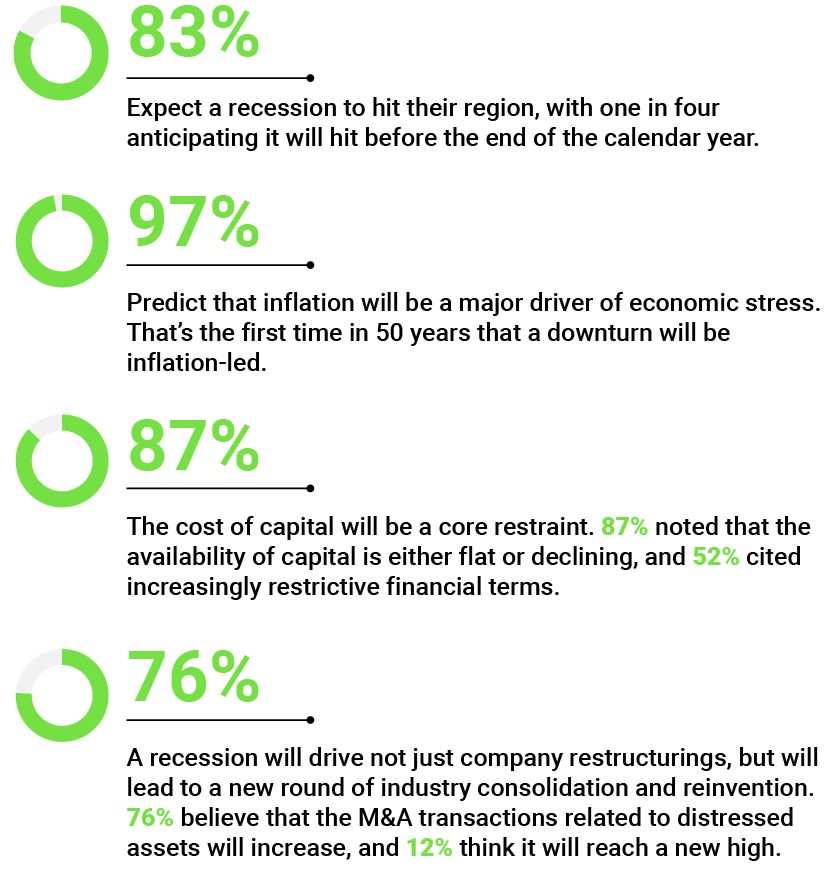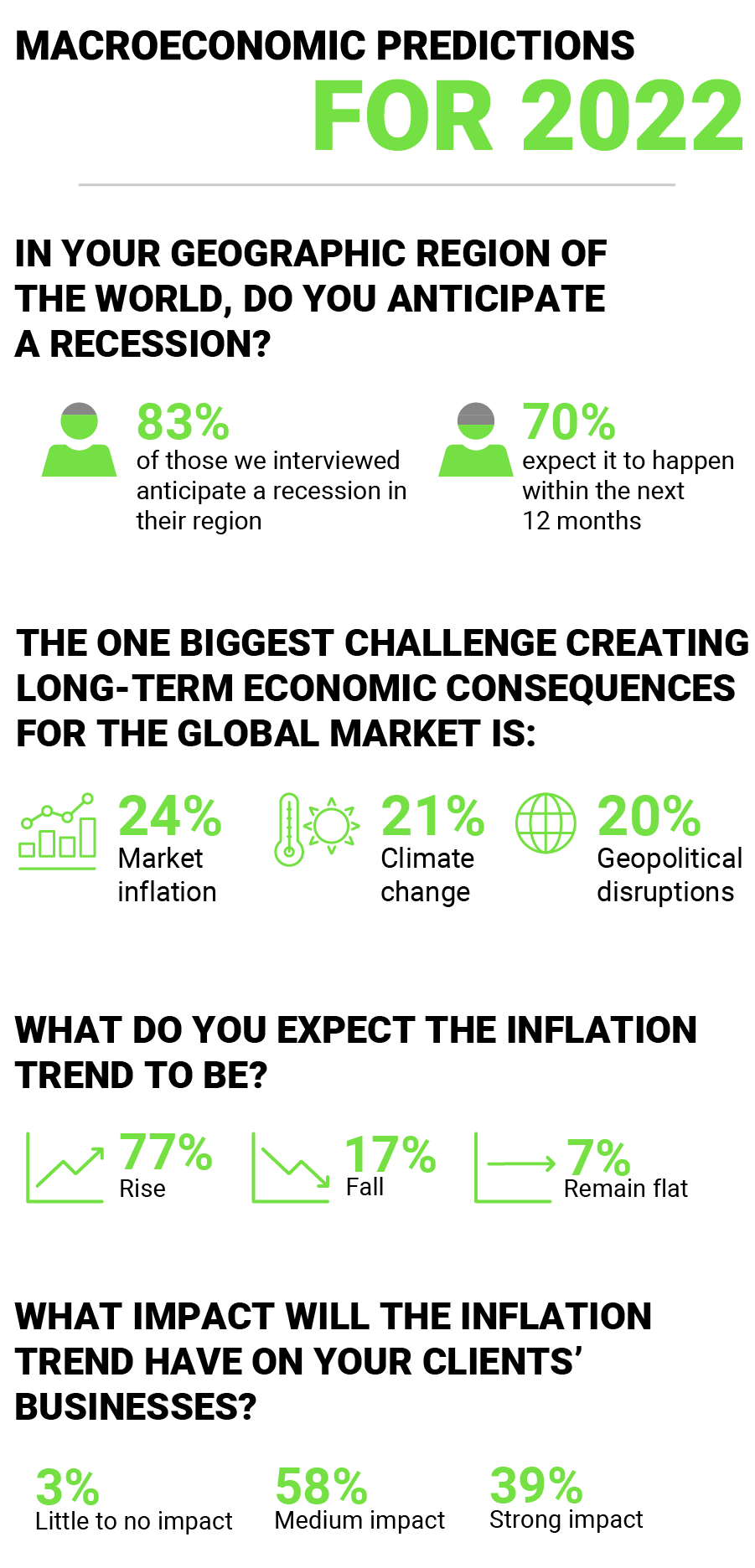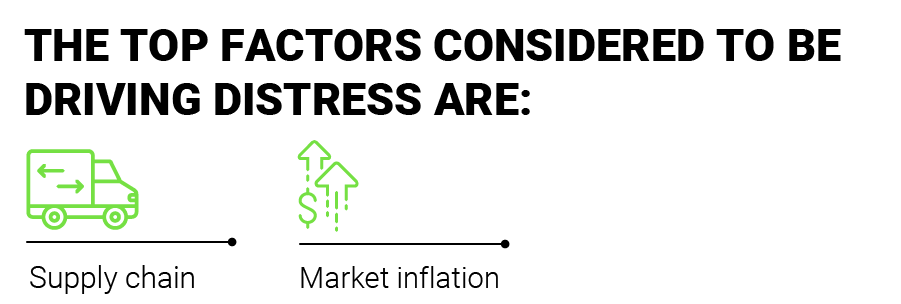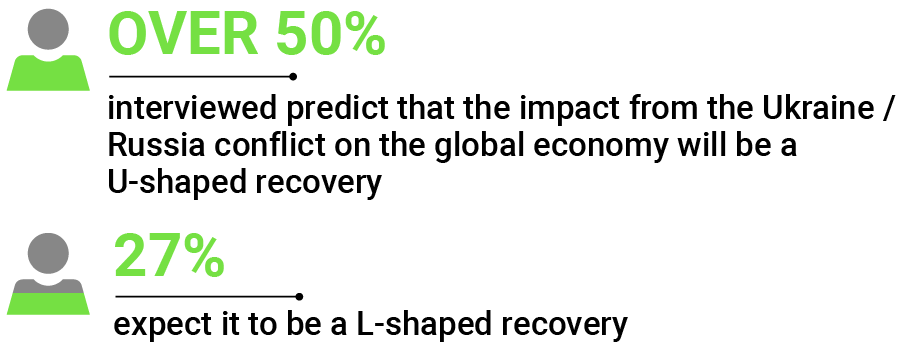PREPARING FOR THE STORM
Insights from the AlixPartners 17th Annual Turnaround and Transformation Survey

PREPARING FOR THE STORM
Insights from the AlixPartners 17th Annual
Turnaround and Transformation Survey


After a red-hot, post-COVID bounce-back, the telltale signs of an impending recession are here: the yield curve has inverted, commodity prices are extremely volatile, the markets have had the worst six months since the financial crisis in 2008, and an emerging asset class – crypto – has imploded. We are in the midst of the pregnant pause: no longer “will it, won’t it?” but rather “when will it?”
While predicting the timing and depth of any economic downturn or even recession is subject to a multitude of variables, in our 17th Annual Turnaround and Transformation Survey, we asked more than 600 of the world’s leading restructuring experts – the professionals most experienced in responding to the downside of economic volatility – how they view the current climate.
While no prediction is ever 100% accurate, this is as close to a consensus forecast as it comes.
After a red-hot, post-COVID bounce-back, the telltale signs of an impending recession are here: the yield curve has inverted, commodity prices are extremely volatile, the markets have had the worst six months since the financial crisis in 2008, and an emerging asset class – crypto – has imploded. We are in the midst of the pregnant pause: no longer “will it, won’t it?” but rather “when will it?”
While predicting the timing and depth of any economic downturn or even recession is subject to a multitude of variables, in our 17th Annual Turnaround and Transformation Survey, we asked more than 600 of the world’s leading restructuring experts – the professionals most experienced in responding to the downside of economic volatility – how they view the current climate.
While no prediction is ever 100% accurate, this is as close to a consensus forecast as it comes.



Just like sailing, preparing for the storm and leaning into it is the best way to get through a downturn. In all cases, the preparations to prevent downside impacts will drive the kind of active management that will achieve positive outcomes no matter the size of the economic waves.
Some no-regret moves will help business leaders to be prepared:
MAKE CASH FLOW A LEADING INDICATOR. Actively monitor cash flows – these are a leading indicator of market shifts and business health. Build cash reserves as best as possible to ensure better resiliency in market volatility.
RENEGOTIATE SUPPLIER PRICING. Call suppliers and ensure that the pricing you are getting actively represents true market costs. Recover price increases that were pending on higher input costs. Don’t be a price taker, lean in and be a price maker.
ASSESS SCENARIOS. Spend time identifying potential scenarios. What would a mild, moderate, and severe recession do to your business? What actions would you take in each? What are the early warning signs that will inspire action? Who in your team is best equipped for what might lie ahead?
CATEGORIZE BUSINESS LEVERS. Define key levers in the business to pull in a downturn. Split them into three categories: easy to reverse, hard to reverse, and mission critical. If a downturn happens, pull the levers in reverse order to mitigate the potential damage that each will do to the business.
PREPARE FOR OFFENSIVE MOVES. Downturns create a buyer’s market. What are the actions you would take to reshape your market, if you could? If you have a plan ahead of time, you will be faster to act when opportunities come available.

The current landscape may inspire anxiety, but now is the time to prepare. If a “turnaround mindset” proved to be a defining factor in establishing a competitive edge during the height of the pandemic, it must now be locked in to effectively tackle a new wave of market volatility. Leadership teams need agility, foresight, and an action-oriented point of view to navigate the choppy waters ahead.



The current landscape may inspire anxiety, but now is the time to prepare. If a “turnaround mindset” proved to be a defining factor in establishing a competitive edge during the height of the pandemic, it must now be locked in as table stakes to effectively tackle a new wave of market volatility. Leadership teams need agility, foresight, and an action-oriented point of view to navigate the choppy waters ahead.
We hope that you find our 17th Annual Turnaround and Transformation Survey insightful and thought-provoking. In addition to these headline findings, below you will find a series of personal perspectives from our Turnaround and Restructuring leadership team. You can also dive deeper into five of the dominant themes that you identified as having the most significant impact on your business and the cause of the most disruption for many of your clients: Corporate Financing, Supply Chains, Inflation, M&A, and ESG.
Study methodology: Research for the 17th Annual Turnaround and Transformation survey was conducted between May 10 and 25, 2022. Respondents comprised 600 lawyers, investment bankers, lenders, financial advisors, and other industry experts involved in corporate workouts representing more than 20 major industries in global locations, including in the US, Europe, Middle East and Africa, and Asia.

Joff Mitchell
Global Co-Head Turnaround
& Restructuring Services
jmitchell@alixpartners.com
+1-212-561-4060


Joff Mitchell
Global Co-Head Turnaround
& Restructuring Services
jmitchell@alixpartners.com
+1-212-561-4060
The biggest drivers of restructuring activity are an increase in the cost of credit and a reduction in the availability of credit.
In other words, if companies are unable to refinance because new finance is either not available or too expensive, those factors are likely to lead to an increase in restructuring activity.

We are seeing the cost of money increasing. Real interest rates have started to rise and – although relatively low by historic standards – they’ve increased quite dramatically in recent times. In addition, in the high-yield bond market and the leveraged loan market, we’ve seen significant outflows of liquidity – negative flow, in fact. If that is a trend that persists, it will likely lead to some companies being unable to or having difficulty in refinancing.
That said, right now, default rates and the number of bankruptcy filings we see remain at historic lows, suggesting that these factors have yet to fully run their course. While no one can pick the precise timing, I firmly believe we are heading for another period of restructuring.

There are, of course, other factors that will also impact corporate performance and can lead to restructuring activities – like recessions, spiking inflation, supply chain issues, and geopolitical conflicts – and all those factors are now in play. This multilayering of disruptive influences stacking on top of the underlying credit market landscape further reinforces the need for leaders to think proactively about how to deal with what lies ahead of them. That includes envisioning what a fully post-pandemic world will look like, amid the myriad of other economic challenges. Companies that get this wrong will likely have to face significant consequences.

Jim Mesterharm
Global Co-Head Turnaround
& Restructuring Services
jmesterharm@alixpartners.com
+1 (312) 551-3265


Jim Mesterharm
Global Co-Head Turnaround
& Restructuring Services
jmesterharm@alixpartners.com
+1 (312) 551-3265
With global commerce we are a much more interconnected society than we were 20 or 30 years ago. This means that conflicts happening far away like the war in Ukraine or workforce disruption in China due to COVID-19 have a far greater impact than before, creating huge challenges for many industries globally.
I believe these factors help to explain why many restructuring experts highlight certain industries as more susceptible to distress than others. In automotive specifically, I see two critical issues. Firstly, the ongoing conflict and pandemic have had an extreme regional and global impact on this industry’s supply chains, such as access to wiring harnesses and other vital raw materials. We also see the enduring impact of chip shortages, which is really impacting auto production globally.
Secondly, the longer-term challenges of electrification will continue to create huge disruption, driven by broader environmental concerns and a concerted shift towards hybrid and full electrification resulting from governments' push for higher fuel efficiency and lower emissions. The big question will be when will we reach that tipping point – the true moment of convergence – when more battery electric and fuel cell electric vehicles are sold than internal combustion or hybrid? Along the way there also will be challenges with new technology upstarts trying to enter the market and scale to production, and a shakeout down the road of legacy suppliers in the internal combustion engine space as demand decreases for their products.
In retail, I think the biggest challenge for many retailers globally will be working their way out of a glut of inventory that has accumulated through previous supply chain imbalances, as well as delays in production and delivery of goods. As a result, some businesses will need to discount to move this inventory. This is important because many retailers largely finance themselves with asset-based loans; these loans are driven by formulas reflecting how much availability lenders are willing to give these companies based on the level of discounting they would need to apply to liquidate inventory if lenders needed to foreclose on their loan collateral.
As a result, we could see retailers without sufficient borrowing capacity to carry this level of inventory, as they may experience a situation where inventory is marked down in order to sell it and, as a result, these increased markdowns compress borrowing base ratios. The consumer base that sees this may then start to think that pricing dynamics have changed, driving them to only want to buy things that are on sale. Thus, the economic relationship retailers have with their customers erodes. Some retailers may hold stock for the following season and adjust future buying behavior accordingly, but not all will have the liquidity to do so.

The full impact of hybrid working post-pandemic is still taking shape though, and we must remember that this industry’s evolution will cause significant ripple effects for the support industries that thrived on the movement of people to and from office spaces globally pre-COVID.
Perhaps the biggest issue is that we're still not done with the pandemic. While major blows have been softened by unprecedented government support around the world, supply chain disruption and demand imbalances will be here for some time to address. I also don't believe the full story has been written on inflation yet either, as we're still seeing how central banks are attempting to control it and the ramifications of those actions.

Axel Schulte
Co-Head Turnaround &
Restructuring Services
- EMEA
aschulte@alixpartners.com
+49 211 97 55 10 53


Axel Schulte
Co-Head Turnaround &
Restructuring Services - EMEA
aschulte@alixpartners.com
+49 211 97 55 10 53
Beyond, first and foremost, the obvious human tragedy, the war in Ukraine represents another huge disruption on top of the many operational issues businesses had been wrestling with before and during the pandemic.
Now, we are not only facing cost increases across all industries, but also the necessity to restructure energy supply across Europe – most notably in Germany – while at the same time keeping production up to respond when demand fully returns. That historical dependency upon Russia is now perhaps the biggest problem, after the country was such a reasonably priced and reliable resource for so long.
Beyond, first and foremost, the obvious human tragedy, the war in Ukraine represents another huge disruption on top of the many operational issues businesses had been wrestling with before and during the pandemic.
Now, we are not only facing cost increases across all industries, but also the necessity to restructure energy supply across Europe – most notably in Germany – while at the same time keeping production up to respond when demand fully returns. That historical dependency upon Russia is now perhaps the biggest problem, after the country was such a reasonably priced and reliable resource for so long.
The global issues with oil and gas are clear, globally, while the automotive industry and manufacturing more broadly require intensive energy use and access to many raw materials that are now in short supply due to events in Ukraine. In such an export-heavy region, the disruption to supply chains and scarcity of goods is driving up prices, and we must also remember the many thousands of Ukrainians who worked in production or logistics roles during normal times but are now fully focused on defending their country.
I believe a U-shaped recovery is what we’ll see unfold. During this conflict, the infrastructure of a country that was an integral part of so many supply chains has been destroyed and will require huge investment and capex to rebuild. The companies affected have to find workarounds, but this isn’t easy. Many workarounds themselves are blocked or hugely problematic due to other political issues and the continued effects of the pandemic. We have talked previously of “perfect storms” – fuel crises and Brexit, among others – but it’s nothing compared to what I see now.
Besides supporting the recovery of Ukraine as much as they can, companies must be fast on their feet, finding stability through flexibility. They need to act on reducing their fixed cost base now because that will build greater resilience. There must be an unbiased analysis of supply chains, assessing over-dependence on any single country or supplier to ensure enough diversification is in place to reduce future risks.
Resilience is a word that has a very different meaning today compared to five years ago. Now we truly see how vulnerable a company can be in the face of so many accumulated disruptive external forces.



I believe a U-shaped recovery is what we’ll see unfold. During this conflict, the infrastructure of a country that was an integral part of so many supply chains has been destroyed and will require huge investment and capex to rebuild. The companies affected have to find workarounds, but this isn’t easy. Many workarounds themselves are blocked or hugely problematic due to other political issues and the continued effects of the pandemic. We have talked previously of “perfect storms” – fuel crises and Brexit, among others – but it’s nothing compared to what I see now.

Besides supporting the recovery of Ukraine as much as they can, companies must be fast on their feet, finding stability through flexibility. They need to act on reducing their fixed cost base now because that will build greater resilience. There must be an unbiased analysis of supply chains, assessing over-dependence on any single country or supplier to ensure enough diversification is in place to reduce future risks.
Resilience is a word that has a very different meaning today compared to five years ago. Now we truly see how vulnerable a company can be in the face of so many accumulated disruptive external forces.

Simon Appell
Co-Head Turnaround &
Restructuring Services
– EMEA
sappell@alixpartners.com
+44 20 7332 5269


Simon Appell
Co-Head Turnaround &
Restructuring Services
– EMEA
sappell@alixpartners.com
+44 20 7332 5269
Our annual survey always reflects strong international perspectives, however this year I have been most struck by the results we have seen from individual territories, which set a distinctly local tone.
Perhaps this tone reflects a stronger sense of introspection, with each region's respondents anticipating that their own market will be the one most likely to experience distress.
In times of tribulation, dominant psychology may stir a narrowing focus upon the areas of immediate impact, ensuring hatches are battened down to ride out the storm.

However, at this time, there is a crucial balance to be established between defensive and offensive strategies. With so many concurrent disruptive forces at play, as well as the quiet restructuring period we've seen in the past 18 months, distress may well be inevitable. Yes, houses must be in order to secure a firm footing for what’s still to come, but an overly cautious approach will likely result in missing the opportunities that always present themselves in times of risk and rapid change.
The extraordinary support packages seen in the most extraordinary of times during the pandemic allowed so many businesses – good and bad – to continue, despite the many constraints inflicted upon them. Perhaps this artificially narrowed the gap between the winners and the losers. As we now accelerate away from COVID-19 to face what could be considered the more frequently observed – albeit extreme – economic challenges of rising inflation, supply chain disruption and geopolitical tension, I expect to see that gap increase again.

Individually, businesses have handled these challenges before. Combined, overcoming them will rely more than ever before on the strongest of management teams. They act quickly and decisively, taking a view, backing it, and acting upon it without compromise. Acting decisively must also account for the likelihood of changing direction as required. Few of us anticipated the events of the past two years. They highlight the need for strategies and priorities to remain flexible, with sufficient agility to chart a different course when the headwinds change direction once more.

Eric Koza
Co-Head Turnaround &
Restructuring Services
– Americas
ekoza@alixpartners.com
+1 (212) 561-4152


Eric Koza
Co-Head Turnaround &
Restructuring Services
– Americas
ekoza@alixpartners.com
+1 (212) 561-4152
The global economy is expected to change significantly in the coming months. Management teams must keep their eyes wide open to this and be proactive in planning strategically and operationally for what comes next.
If that isn’t the collective mindset from the get-go, how can any future opportunities be harnessed?
It is vital that companies are appropriately set up from a financing standpoint. Is there sufficient liquidity and will capital structures be able to survive what is expected to be a bumpy ride? More liquidity is better than less when you believe uncertainty lies ahead, because it's harder to raise it when you need it, rather than while you don't need it. This reinforces the need for preparation, getting ahead rather than reacting at a time when you might not have the broadest range of options available.

Those options could include, for example, opportunities for companies with the appropriate capital structure to look at how they could pick up weaker players via M&A and build greater competitiveness for the long term. Other options include cost-cutting measures like reassessing geographic areas of challenge, taking strategic action to either prune or grow depending on the market dynamics being faced.

The result may be that there are cost savings and greater efficiency. But your method should also be more thoughtful about how you go to market, how you compete, how you innovate, and how you invest. Ultimately, you should ask yourself, how should you do things differently?
People are creatures of habit in many ways, but management teams absolutely cannot rely on continuing to do what they’ve always done before. I often see two camps with management teams: those that have learned to grow a company and those that have learned to operate in a downturn. Growing a company when you've got the wind at your back is a very different skill set to surviving and seizing opportunities that arise when you're running uphill against the gale.


